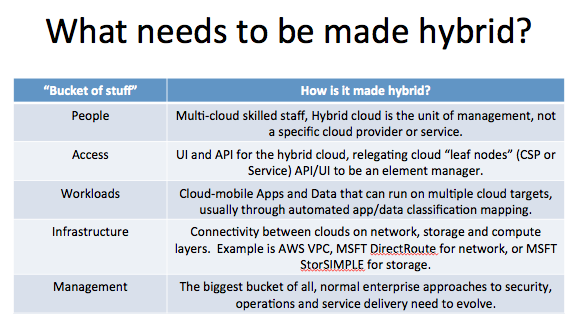The CEO of VMware recently said, “private cloud is a dead end and public cloud is a cul-de-sac“. This from a smart, successful multi-billion dollar company that sells private and public clouds. It turns out that whilst each are individually awesome, sometimes neither is good enough on its own for everything a business needs unless you’re a small startup in a big city. Either your private cloud doesn’t scale enough or your public cloud is in the wrong country: there’s always something wrong or missing for one of your important workloads so people are starting to mix private and public clouds together to make their own hybrid cloud.
You can’t buy a hybrid cloud as a product nor as a service, and even if you could you would need to customise it for your unique requirements and constraints. The reality today is you need to buy the ingredients from a supplier then roll your own hybrid cloud and to manage this you need to put in place a Hybrid Cloud Manifesto.
The evolution of the hybrid cloud
Cast your eyes for a moment across the Fortune 500 companies. Compare the IT landscape in any two of them and you’ll find a different mix of legacy IT, advanced virtualization, private cloud and public cloud usage. Even if those two companies are in the same market their business DNA is unique and this is reflected in their IT landscape.
Walk through the doors of any Fortune 500 company and look around the offices, perhaps head down to the gymnasium. In the red corner you’ll find The Private Cloud Team who insist that all IT needs can be delivered via them (apart from the mainframe stuff, but they’re too overweight to even get into the ring); and in the blue corner will be The Public Cloud Team who insist that all the IT needs can be delivered via them (apart from the mainframe stuff, but they’re too old to even get into the ring) . Watching noisily from the sidelines is The Mainframe Team, ripping up and throwing chairs into the ring.
Fortune 500 companies and their IT landscapes are complex things. They are organic and suffer from entropy; they are measured by management on keeping the lights up whilst castigated by their customers for not being consumer focused enough. If an IT vendor or cloud service provider doesn’t recognise these torments and tries to force a company to adhere to one dogmatic strategy: this is how you can finish in a cul-de-sac.
What has been happening in the industry for a few years now, and what Pat and VMware recognise as becoming mainstream, is the evolution of cloud from discrete models of private OR public OR hosted clouds into variably unified hybrid clouds where you have a unified control plane and shared data planes to map workloads to target clouds depending on your needs.
Is this marketing, or reality? I asked a respected technologist at a large enterprise, “How did you evolve from pockets of cloud to a hybrid cloud?” and here’s what that person said under condition of anonymity:
I’m not sure what constitutes a hybrid cloud in a way that’s consistent with my peers in different organizations, and I don’t feel it’s valuable arguing about definitions. If you look at all the reference architectures out there they’re all different and some vendor ones are just cloud washing. I think we’ve got something here that looks like an emerging hybrid cloud because we do some hybrid cloud things, like networking and some management, but then again we don’t do everything in a hybrid manner: is there a standard? I haven’t found one. And even if there was it would probably be over complex and not fit for our business.
Instead, we were already turning our virtualization platform into a private cloud and we also had some public cloud. We connected the networks between our datacenter and the public cloud. We can map workloads to clouds via a single catalogue, but there’s more to do on the management end for users and all the rest. A test of our success is being able to add and remove cloud services and whole cloud service providers, and move workloads as appropriate between them, at some point in the future.
I would argue that this is a common experience amongst IT practitioners today. Instead of someone sitting down with a blank piece of paper and designing a hybrid cloud from scratch, what people are doing is evolving their current use of clouds into a hybrid solution that fits their needs and gives them options for the uncertain future.
Stu Miniman and I discussed the IT evolution leading up to hybrid cloud on my first CUBEconversations video:
Your hybrid cloud
The simplest visualization I have seen of hybrid cloud was in a whiteboard drawing of a tree:
- the entire picture is the hybrid cloud
- the trunk is the unified and shared control and data planes
- the branches as cloud providers and
- the leaves as cloud services.
In organizations with high levels of engineering capability and relatively greenfield landscapes and low levels of regulatory or regional compliance, think startup, then they have been able to exploit the capabilities of a single cloud service provider.
In other businesses, think mature enterprise where capabilities, landscapes and constraints are different, then the cloud landscape starts to look much more fragmented and the desire to architect a level cohesion is typically the start of a hybrid cloud effort.
It is common for an enterprise to have some on-premises private cloud, some off-premises private cloud at a partner hosting company, and some off-premises public cloud out there. Add to this the applications consumed as a service, like Office 365 and Salesforce and you have a simple example of the typical complexity of enterprises:

The orange box is where IT practitioners spend time on hybrid cloud activities and, depending on your preference on how to slice up the activities because TMTOWTDI (Tim Toady!), each of the following areas can be hybrid or isolated and this is why no two hybrid clouds are the same. Think of this as a super-abstract of the many cloud reference architectures out there:

Even in the simple list above, you get a sense of the complexity inherent in hybrid clouds. They are not for the faint hearted, but think about the alternatives:
- IT decides to deploy an isolated on-premises private cloud, perhaps because on-premises virtualization is your comfort zone. As it is being released to the business the CIO gives an update to the board and the classic question comes up, “So I hear that the costs of storage are plummeting down to cents and it’s easy to get infinite storage. I can’t wait until we can use that…” Unless a hybrid cloud approach is in place, with the ability to add a cloud service without duplicating all the management, then IT fragmentation and entropy will ensure. You are pushing yourself down a dead-end.
- IT decides to consume an isolated off-premises public cloud, after all everyone’s raving about it on twitter and your users are constantly asking for it. You sign up with a well-known cloud service provider and as it’s being released to the business the CIO gives an update to the board and the classic question comes up, “So, I hear that now it’s cheaper to use another well-known cloud service provider, what are our plans to swap?”. You have tied yourself to one CSP and you are in a cul-de-sac.
Hybrid clouds are not a myth they are a reality today, evolving and emerging in response to real business need. VMware has talked to all of those Fortune 500 companies, some for many years, so if you listen to what VMware say in their strategy, and also listen to what their competitors are talking about, then you will know that hybrid is emerging as the main boulevard in enterprise cloud city.
Everyone’s at it: Microsoft, Red Hat, Oracle, IBM, HP, EMC, Cisco. AWS are reaching out of their regions and into your datacenter. Google are partnering with VMware.
Hybrid is everywhere, but it is well camouflaged in the enterprise IT jungle because it isn’t a distinct product, but an evolving mix of the old and the new.
Action Item
CIOs need to document their Hybrid Cloud Manifesto and use lean enterprise principles to develop their unique Hybrid Cloud.
The manifesto is a collection of cloud provider-centric answers to cloud consumer-centric needs (e.g. developers, users, security, operations) and should explain the following.
- Why the hybrid cloud is required – just pick one fine example from the list of requirements and constraints (these can be documented elsewhere).
- What does near term success look like?
- What are the less clear long term goals to keep in mind?
- Who are the consumers?
- What does the hybrid cloud provide to them (keeping lean/MVP in mind, not solutioning for all possible scenarios, keep it focused)
- Who are the providers – cloud service providers and cloud services?
- Timelines and deliverables.
Key to this manifesto is the spirit of not producing a product: hybrid cloud is not something that will be “completed” because as it is delivered, customer requirements will change, constraints will move and suppliers and providers will develop their offerings. Therefore, the combinations and integrations that make up a hybrid cloud will constantly move and the response is an agile development that can absorb and eject cloud services over time.
Further reading
Hybrid Cloud isn’t a product, it doesn’t have a SKU. It’s variously described as a promise, a strategy, an architecture and a solution. But that’s ok, because the reality is that a hybrid cloud is unique to each business according to their needs.
Here are some example reference architectures and other resources for practitioners to digest (I am not responsible for the quality or content for these third party reference architectures, and these are selected for illustration of the varied approaches).
- VMware Hybrid Cloud and Reference Architecture: Building your Hybrid Cloud with vCAC, vCHS and NSX
- EMC Enterprise Hybrid Cloud 2.5.1
- Microsoft Hybrid Cloud Infrastructure Solution for Enterprise IT
- IBM Cloud Computing Reference Architecture
- Oracle Cloud Reference Architecture
- Red Hat Hybrid Cloud
- Google and VMware Partner on Hybrid Cloud


